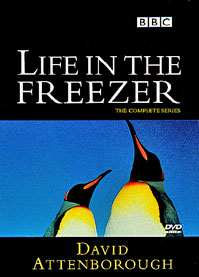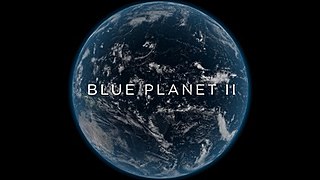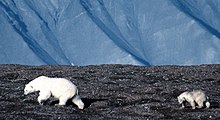
Sir David Frederick Attenborough is a British broadcaster, biologist, natural historian, and writer. He is best known for writing and presenting, in conjunction with the BBC Natural History Unit, the nine natural history documentary series forming the Life collection, a comprehensive survey of animal and plant life on Earth.

Life in the Freezer is a BBC nature documentary series written and presented by David Attenborough, first transmitted in the United Kingdom from 18 November 1993.

George Richard Ian Howe, known professionally as George Fenton, is an English composer. Best known for his work writing film scores and music for television, he has received five Academy Award nominations, several Ivor Novello, BAFTA, Golden Globe, Emmy and BMI Awards, and a Classic BRIT. He is one of 18 songwriters and composers to have been made a Fellow of the Ivors Academy.
The BBC Studios Natural History Unit (NHU) is a department of BBC Studios that produces television, radio and online content with a natural history or wildlife theme. It is best known for its highly regarded nature documentaries, including The Blue Planet and Planet Earth, and has a long association with David Attenborough's authored documentaries, starting with 1979's Life on Earth.

A nature documentary or wildlife documentary is a genre of documentary film or series about animals, plants, or other non-human living creatures. Nature documentaries usually concentrate on video taken in the subject's natural habitat, but often including footage of trained and captive animals, too. Sometimes they are about wildlife or ecosystems in relationship to human beings. Such programmes are most frequently made for television, particularly for public broadcasting channels, but some are also made for the cinema. The proliferation of this genre occurred almost simultaneously alongside the production of similar television series which is distributed across the world.

Planet Earth is a 2006 British television series produced by the BBC Natural History Unit. Five years in the making, it was the most expensive nature documentary series ever commissioned by the BBC and also the first to be filmed in high definition. The series received multiple awards, including four Emmy Awards, a Peabody Award, and an award from the Royal Television Society.

Alastair David William Fothergill is a British producer of nature documentaries for television and cinema. He is the series producer of the series The Blue Planet (2001), Planet Earth (2006) and the co-director of the associated feature films Deep Blue and Earth.
This is a chronological list of selected television programmes and feature films produced or co-produced by the BBC Studios Natural History Unit since its inception in 1957. It is not intended to be exhaustive given the large amount of material the Unit has produced in its history, but it does capture all the major TV series and films for which it has gained recognition. A brief synopsis of Pre 1957 radio and television programmes on a natural history theme made by the BBC is given in the History section of the main BBC Studios Natural History Unit article.

Planet Earth: The Future is a 2006 BBC documentary series on the environment and conservation, produced by the BBC Natural History Unit as a companion to the multi-award-winning nature documentary Planet Earth. The programmes were originally broadcast on BBC Four immediately after the final three episodes of Planet Earth on BBC One. Each episode highlights the conservation issues surrounding some of the species and environments featured in Planet Earth, using interviews with the film-makers and eminent figures from the fields of science, conservation, politics, and theology. The programmes are narrated by Simon Poland and the series producer was Fergus Beeley.

Frozen Planet is a 2011 British nature documentary series, co-produced by the BBC ZDF and The Open University. It was filmed by the BBC Natural History Unit. The production team, which includes executive producer Alastair Fothergill and series producer Vanessa Berlowitz, were previously responsible for the award-winning series The Blue Planet (2001) and Planet Earth (2006), and Frozen Planet is billed as a sequel of sorts. David Attenborough returns as narrator. It is distributed under licence by the BBC in other countries, Discovery Channel for North America, ZDF for Germany, Antena 3 for Spain and Skai TV for Greece.

The Living Planet: A Portrait of the Earth is a BBC nature documentary series written and presented by David Attenborough, first transmitted in the UK from 19 January 1984.

Nature's Great Events is a wildlife documentary series made for BBC television, first shown in the UK on BBC One and BBC HD in February 2009. The series looks at how seasonal changes powered by the sun cause shifting weather patterns and ocean currents, which in turn create the conditions for some of the planet's most spectacular wildlife events. Each episode focuses on the challenges and opportunities these changes present to a few key species.
The following is a chronological list of 148 television series and individual programmes in which Sir David Attenborough is credited as a writer, presenter, narrator, producer, or interviewee. In a career spanning eight decades, Attenborough's name has become synonymous with the natural history programmes produced by the BBC Natural History Unit.
Keith Scholey is a British producer of nature documentaries for television and cinema, and a former television executive. He is currently a joint Director of Silverback Films Ltd and Studio Silverback Ltd.

Deep Blue is a 2003 nature documentary film that is a theatrical version of the 2001 BBC nature documentary series The Blue Planet. Alastair Fothergill and Andy Byatt are credited as directors, and six cinematographers are also credited. The film premiered at the San Sebastian Film Festival in Spain on 20 September 2003. It screened in over 20 territories from 2003 to 2005 and grossed over $30 million at the box office.

The Hunt is a 2015 British nature documentary series made for BBC Television, first shown in the UK on BBC One and BBC One HD on 1 November 2015. The series is narrated by David Attenborough.

Planet Earth II is a 2016 British nature documentary series produced by the BBC as a sequel to Planet Earth, which was broadcast in 2006. The series is presented and narrated by Sir David Attenborough with the main theme music composed by Hans Zimmer.
Planet Earth is a television and film documentary franchise produced and broadcast by the BBC. The franchise began in 2001 with the success of The Blue Planet. As of 2017, The Blue Planet has spawned 5 series and one feature film.

Blue Planet II is a 2017 British nature documentary series on marine life produced by the BBC Natural History Unit. Like its predecessor, The Blue Planet (2001), it is narrated and presented by the naturalist Sir David Attenborough.

Syracosphaera azureaplaneta is a species of coccolithophore. This oceanic phytoplankton is not common, but is widely distributed and is known to occur in all the major seas, from tropical to sub-arctic regions. It is named after the BBC TV documentary series, The Blue Planet.




















